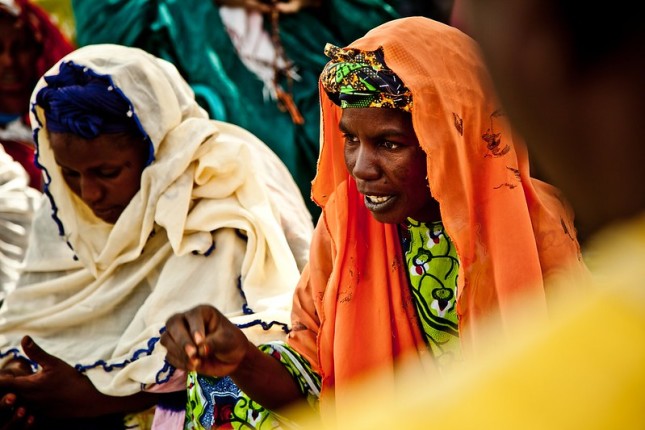-
Investing in Girls and Women Could Set Stage for Peace, Development in Sahel
April 21, 2020 By Alisha Graves
The coronavirus pandemic has people throughout the world pondering how humankind should respond to a public health crisis. While individual countries are managing the crisis with varying degrees of success, we can all agree that the Covid-19 pandemic is commanding the international community’s attention. By contrast, it is much harder to get the world to care about the long-term public health crisis unfolding in the West African Sahel.
Population growth is outpacing the food supply in the Western Sahel, which lies between the Sahara to the north and the Sudanian Savanna to the south. Our analysis and work is focused in Senegal, Mauritania, Burkina Faso, Mali, Niger, Chad, and northern Nigeria. By 2050, its population is expected to more than double to 450 million and temperatures are expected to be about 3° Celsius above their 1950 level.
Hunger and Population Growth
Hunger and malnutrition are already widespread in the region. Four out of 10 children in Niger are stunted and will never achieve their full human potential. Throughout the region, the absolute number of people who are undernourished is increasing. Even if the proportion of malnourished people is cut in half in the next 20 years—a great win on the face of things—the absolute number of people who are hungry will remain the same, due to population growth.
Relief organizations are struggling to meet the demand for emergency food assistance. Over the past five years, humanitarian needs in the West African Sahel averaged more than $2 billion, but only 53 percent was funded. Drought and other weather extremes will make it even harder for farmers to produce the crops and livestock needed to sustain the rapidly growing population.
Food shortages and young age structures directly correlate to conflict and civil unrest. While the region for a long time was relatively peaceful, in recent years it has seen an upswing in violence. As the security situation worsens, governments are spending more on military and police forces and less on social services.
Why It Makes Sense to Invest in Girls and Women
Together with experts from the region, in a comment in Nature, we called on governments worldwide to work with Sahel country governments by investing in girls’ education, expanding access to voluntary family planning, increasing agricultural production, and improving security. Girls’ education and family planning are basic human rights, but also act as levers on demography. The longer girls stay in school, the later they tend to marry and the more decision-making power they have, including whether to use contraception. Educated girls are more likely to work outside the home and generally desire—and have—smaller families. In all Sahel countries except Senegal, women with “unmet need,” or those who want to space their children two years apart or avoid pregnancy altogether, outnumber women who use modern contraception. If girls’ education and family planning are prioritized on a regional scale in the near term, we predict it will slow population growth, laying the foundation for sustainable development and peace in the Sahel.
Funding Shortfall
In 2018, a group of European donors, the African Development Bank, and the United Nations Development Programme formed Alliance Sahel to increase and better coordinate aid to the region. It is, in part, a response to the formation of the G5 Sahel, a framework for regional cooperation in development and security matters. The OASIS Initiative, a University of California, Berkeley project, together with partners in the Sahel and Europe, are advocating for increased funding for girls’ education and voluntary family planning from Alliance Sahel members and observer institutions. Evidence already suggests that the Alliance Sahel’s mission to “enhance the stability and global development of the region” will be more achievable in the context of increased women’s autonomy and slower population growth.
The Copenhagen Consensus Center estimates that for every U.S. dollar invested in family planning, the return is $120, making it one of the most cost-effective approaches for sustainable development. The United States gives by far the greatest international family planning assistance. Yet globally, only 1 percent of the overall flow of foreign aid goes to family planning. Digging deeper, OASIS has begun analyzing OECD data to identify trends in overseas development aid from key donors to the G5 Sahel countries, plus Nigeria and Senegal. Our preliminary findings showed the percentage of all overseas development aid for girls’ education declined between 2007 and 2017. Investment for family planning increased slightly in this period, but European aid remains woefully low.
Early Investment Saves Lives
As Covid-19 is demonstrating, governments and international institutions do not do a good job of anticipating crisis. This deficiency is even more marked when crises take several decades to unfold, as is happening in the Sahel. An example of one such long-term crisis is the HIV/AIDS epidemic. By the mid-1980s, there was compelling evidence that HIV/AIDS could become a major pandemic. Yet the annual budget of the earliest USAID-funded program to slow AIDS in Africa was less than one-half of 1 percent of the amount the global health community spent on HIV/AIDS in 2015 ($25 million vs. $49 billion). In retrospect, a much greater investment in preventing the spread of the disease in the 1980s could have saved money and millions of lives decades later. AIDS has killed an estimated 35 million people in Africa.
Over the next three decades, population growth and climate change in Sahel will threaten the well-being of an estimated 200 million people, undermining food security, exacerbating conflict and terrorism, and driving unprecedented levels of migration, especially to Europe.
Recent meetings with development agencies suggest that donors understand the connections between rapid population growth, development, and security. But they may be uncomfortable discussing them or may be uninformed that demography can be shaped in ways that uphold the rights of girls and women. Caution and sensitivity around discussing these links make sense given colonial history and egregious examples of reproductive coercion. Establishing the links between population, development, and security may help to engage new partners in health and education efforts, including ministers of finance and defense. Yet the most important rationale for investing in girls’ education and family planning remains: These are fundamental human rights.
Equality for women will only be possible once girls are as educated as boys, and women have the information and means they need to achieve the family size they want.
Alisha Graves, MPH, is Academic Coordinator of the OASIS Initiative at the University of California, Berkeley and President of the non-profit Venture Strategies for Health and Development.
Sources: Copenhagen Consensus, Environmental Research Letters, Nature, “The Age-structural Theory of State Behavior” by Richard Cincotta, UN Department of Economic and Social Affairs, World Food Programme.
Photo Credit: Women explain effects of drought in Diaout, Mauritania, February 2012. Photo by Pablo Tosco, Oxfam.
 A Publication of the Stimson Center.
A Publication of the Stimson Center.






